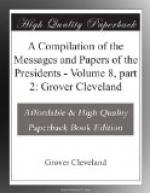In February, 1834, Sir Charles R. Vaughan, after submitting certain observations intended to controvert the positions assumed by the United States on the subject of the constitutional difficulty by which the American Government was prevented from acquiescing in the arrangement recommended by the King of the Netherlands for the settlement of the boundary in the neighborhood of the St. John, asserted that the two Governments bound themselves by the convention of September, 1827, to submit to an arbiter certain points of difference relative to the boundary between the American and British dominions; that the arbiter was called on to determine certain questions, and that if he has determined the greater part of the points submitted to him his decision on them ought not to be set aside merely because he declares that one remaining point can not be decided in conformity with the words of the treaty of 1783, and therefore recommends to the parties a compromise on that particular point; that the main points referred to the arbiter were three in number; that upon the second and third of these he made a plain and positive decision; that upon the remaining point he has declared that it is impossible to find a spot or to trace a line which shall fulfill all the conditions required by the words of the treaty for the northwest angle of Nova Scotia and for the highlands along which the boundary from that angle is to be drawn; yet that in the course of his reasoning upon this point he has decided several questions connected with it upon which the two parties had entertained different views, viz:
“First. The arbiter expresses his opinion that the term ‘highlands’ may properly be applied not only to a hilly and elevated country, but to a tract of land which, without being hilly, divides waters flowing in different directions, and consequently, according to this opinion, the highlands to be sought for are not necessarily a range of mountains, but rather the summit level of the country.
“Second. The arbiter expresses his opinion that an inquiry as to what were the ancient boundaries of the North American Provinces can be of no use for the present purpose, because those boundaries were not maintained by the treaty of 1783 and had in truth never been distinctly ascertained and laid down.




